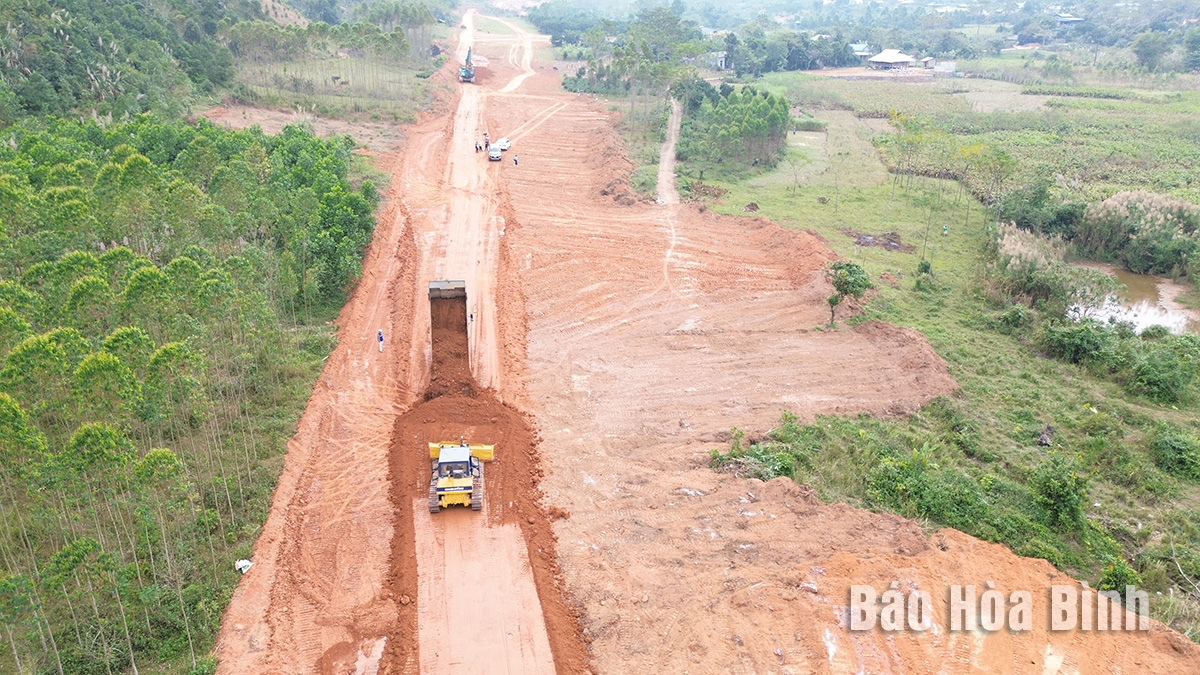
The air is thick with the hum of drills and the clatter of machinery as the Hoa Binh – Moc Chau expressway takes shape amid the rugged terrain. Welding sparks illuminate the faces of workers, and concrete mixers churn relentlessly, laying fresh pavement on the newly-carved road. The construction site buzzes with a palpable sense of urgency, particularly in Hoa Binh province where the expressway's future is being forged.

Machinery and materials are used to build Hoa
Binh – Moc Chau expressway.
Spanning nearly 34km through Hoa Binh, the expressway costs nearly 10 trillion
VND (400 million USD). After months of construction, the project has made
strides. As of early March, over 80% of the land clearance was completed,
allowing construction units to mobilise resources efficiently. Mai Chau
district has handed over all required land (10.15km), while Da Bac district has
cleared nearly 78% of its section (17 out of 21.75km). The Van Ho segment in
Son La province is in the final stages of compensation and clearance, with
completion anticipated by the second quarter.
This progress reflects the dedication and coordinated efforts of local
authorities, the provincial Party Committee, and the provincial People's
Committee.
Despite its progress, the project still faces challenges. The terrain is
unforgiving, with complex geological conditions and unpredictable weather,
including persistent fog and drizzle. Funding and disbursement issues also loom
large, posing concerns for stakeholders.
The final bidding and contracting for construction and consultancy packages are
slated for completion in March. Once finalised, the expressway will enter
full-scale construction, aiming to eliminate bottlenecks and maximise
efficiency before the rainy season begins.
With unwavering determination and coordinated efforts from all involved
parties, the project is steadily overcoming obstacles to accelerate progress.
The goal is to complete the expressway by 2027, a full year ahead of the
original 2028 schedule. This accelerated timeline underscores the urgency to
put the expressway into operation as swiftly as possible.
The Standing Board of the Hoa Binh provincial Party Committee has agreed in principle on a proposal by the Standing Board of the Party Committee of Hoa Binh city to gather feedback on the city’s 1:2000 zoning plan, which forms part of its broader urban development strategy.
Hoa Binh province has made notable progress in public administration reform and digital government development, with the satisfaction index among citizens and businesses reaching over 84%, according to recent government evaluations.
Thanks to great efforts by local authorities in recent times, the governance and public administration performance of Mai Chau district has been significantly improved.
In the afternoon of June 6, the Party Committee, the People's Council, the People's Committee and the Fatherland Front of Lac Son district solemnly held a meeting to celebrate the 139th anniversary of the district's founding (1886–2025) and the 79th anniversary of the establishment of the district's Party Committee (1946–2025). There was the attendance of Mr. Bui Van Thang, the Vice Chairman of the Provincial People's Council; Mr. Quach Tat Liem, the Vice Chairman of the Provincial People's Committee; Ms. Dang Bich Ngoc, the Deputy Head of the National Assembly Delegation of the province; as well as the former leaders of the province and district through various periods, who are the natives of the district.
Implementing the Politburo’s Resolution No. 57-NQ/TW on breakthroughs in science – technology, innovation, and digital transformation is a golden opportunity for the northern mountainous province of Hoa Binh to renew growth model, improve competitive edge and shorten digital gap.
Resolution 57-NQ/TW, issued by the Politburo on December 22, 2024, identifies sci-tech, innovation, and digital transformation as strategic breakthroughs to build a developed and prosperous nation. In Hoa Binh province, this spirit is not just a slogan, it’s being put into action through concrete initiatives that form a "new development triangle”: digital citizenship, digital economy, and digital administration.



